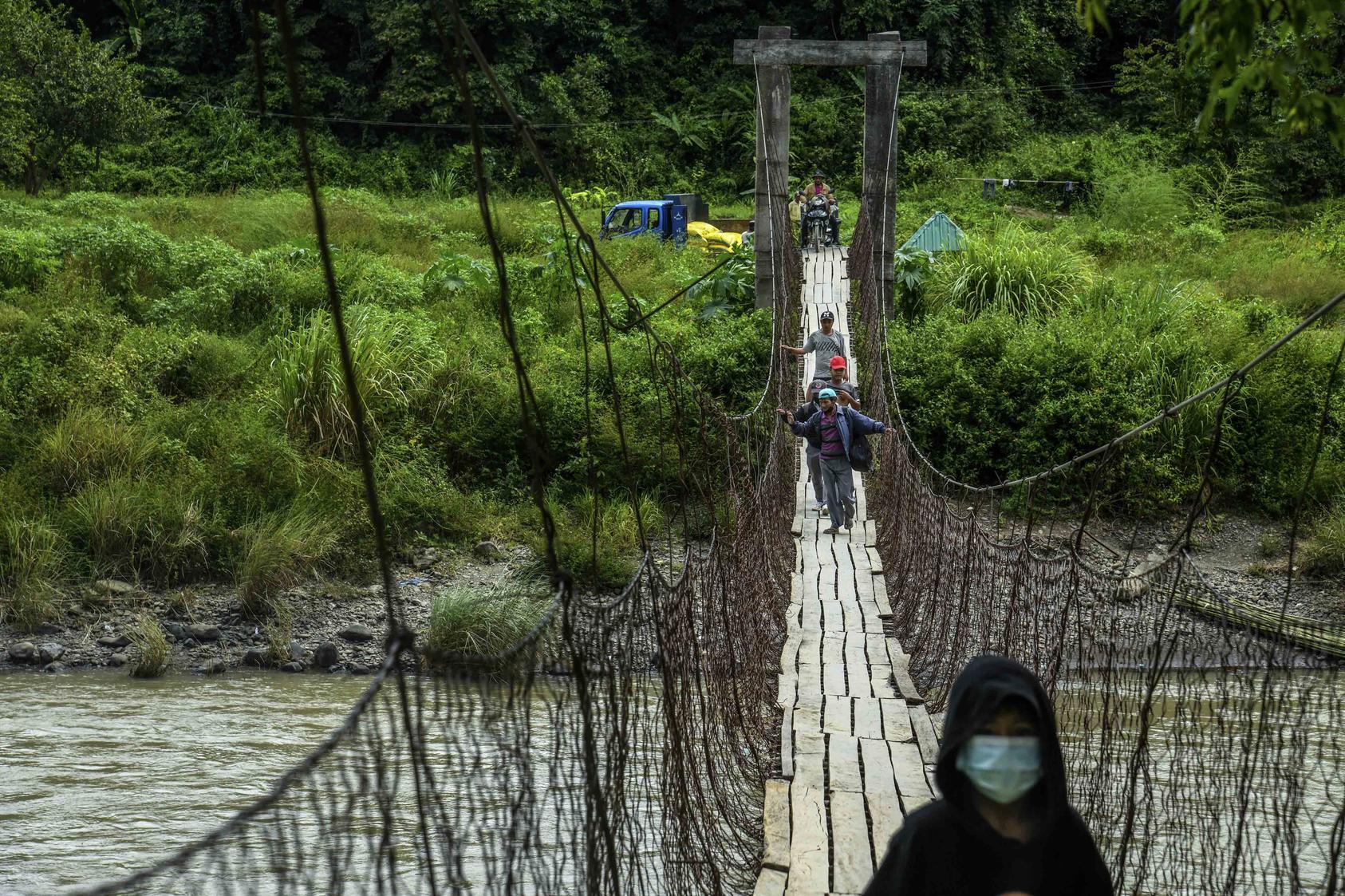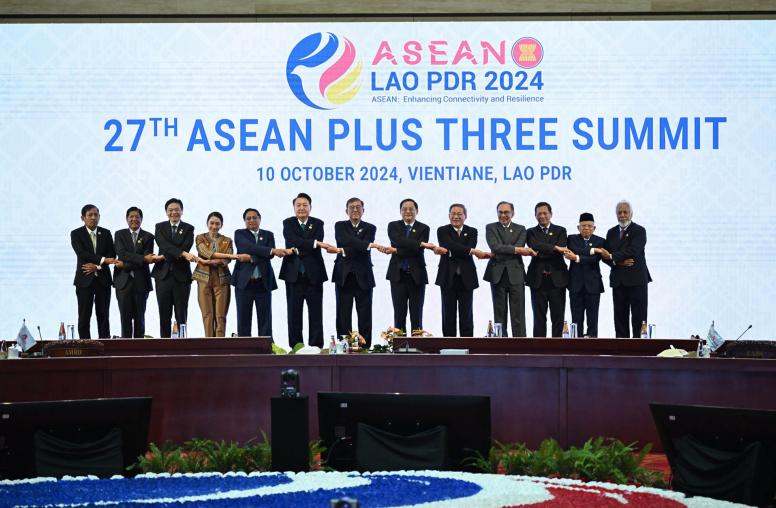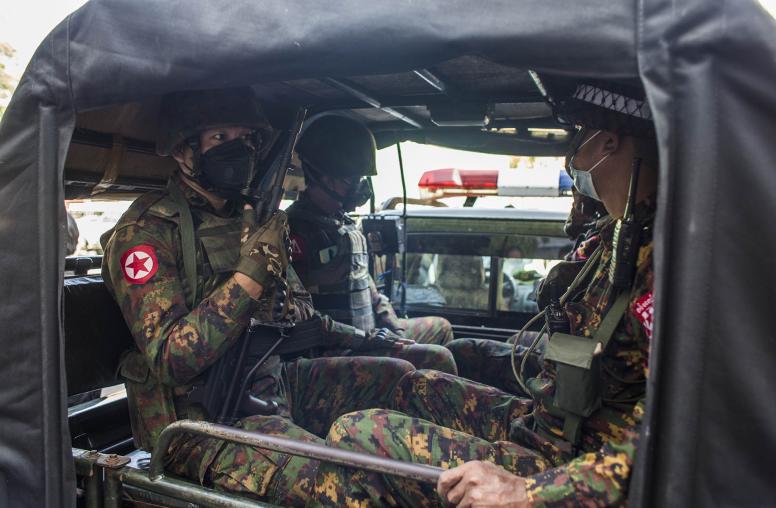Over a Year Later, Myanmar’s Military Coup Threatens India’s National Security
Pressure of refugees, potential for cross-border violence and threat to key projects are top challenges.
The conflict in Myanmar triggered by the February 1, 2021, military coup that toppled the democratically elected government has not only become a disaster for Myanmar, but also for countries across the region. China’s response has received considerable international attention, as has the struggle within the Association of Southeast Asian Nations to forge a resolution to the conflict. The impact on Myanmar’s western neighbors, however, has largely gone unexamined — with the exception of analysis of the consequences for Rohingya refugees, who are indefinitely stranded in Bangladesh with no chance of safely returning to Myanmar under this military regime.

The coup has significantly undermined India’s economic and security interests in Southeast Asia. The multi-dimensional civil war in Myanmar has made progress on India’s economic and logistics projects in the country, which are central to India’s Act East policy, all but impossible. Furthermore, fighting between Myanmar’s military and the People’s Defense Forces (PDFs), which formed to defend communities against the military’s onslaught, has brought intense conflict to the western and northwestern parts of Myanmar, which border India. The PDFs in northwestern Myanmar, working in tandem with Myanmar’s ethnic armed organizations (EAOs) and using guerrilla-style tactics against military forces trained for conventional warfare, have captured significant territory from Myanmar’s military. This has thwarted the military’s effort to consolidate power and weakened its capacity to support India’s counterinsurgency efforts against Indian EAOs that operate from Myanmar. As it has lost ground in India’s borderlands, Myanmar’s army has instead sought assistance from Indian EAOs. These groups, which New Delhi sees as a major national security threat, have partnered with the military junta to attack pro-democratic PDFs and EAOs in the border areas of Myanmar and India.
Although the Myanmar military’s actions have fundamentally undermined India’s interests, New Delhi continues to maintain close ties with the junta — an institution universally reviled in Myanmar, and which has once again turned Myanmar into a global pariah. If instead, India was to distance from the military junta, provide humanitarian assistance to Myanmar refugees, and engage the deposed National Unity Government (NUG) in Myanmar, it would not only strengthen the democracy movement in Myanmar in a way that could help conclude the civil war, but it would generate enormous goodwill from the Myanmar public that would benefit India’s long-term interests in the country.
A Refugee Crisis
The intensity of the conflict is forcing tens of thousands of people to flee their homes in Myanmar and seek refuge in India’s fragile northeastern states. Beginning in March 2021, refugees started to cross over from Myanmar into India’s northeastern states. Among the first wave were leaders of the Civil Disobedience Movement (CDM), including organizers of anti-coup protests, striking civil servants, military and police defectors, teachers and student activists. By April, as Myanmar’s military stepped up its attacks on civilians in Chin State and Sagaing Region, the number of people fleeing to India increased. Among them, reportedly, were members of the PDFs.
According to the United Nations High Commission for Refugees (UNHCR), an estimated 22,000 refugees have entered India from Myanmar since February 2021, with an estimated 7,000 crossing into Manipur and Mizoram States in the second half of January 2022 alone. Tens of thousands more are looking to cross but have been delayed due to COVID-19 lockdowns.
The border crossings have generated significant tensions between district administrations in Manipur and Mizoram, which have welcomed refugees with open arms, and the central government in New Delhi, which has issued orders not to open camps or provide assistance. The government of India fears that the acceptance of refugees might cause tensions with Myanmar’s military regime.
Manipur’s state government, meanwhile, faced strong popular outcry from the state’s population, which has deep socio-ethnic links to ethnic communities in Myanmar. Under pressure, it has required Indian paramilitary forces guarding the border to look the other way as refugees cross.
A Challenge for India
The sudden influx of refugees from Myanmar poses significant challenges to India. These challenges include: security risks and burdens to local populations as refugees make the long journey across India without proper access to food or medicine; the possible spread of infectious diseases, including COVID-19; and growing tensions between New Delhi and the state governments of Mizoram and Manipur over how to manage the influx of refugees.
India is not party to the 1951 Refugee Convention or its 1967 Protocol and lacks a national framework for the protection of refugees. India has chosen not to sign the refugee conventions and protocol, and has historically cited national security interests and challenges to its sovereignty as key concerns. The government of India, along with the governments of other South Asian countries, asserts that migration is a matter of bilateral and not multilateral relations, which should not be governed by international agreements. India has held that cross-border movements affect political stability and internal security, including the country’s already fraught demographic balance.
Instead, India grants asylum to a large number of people from neighboring states and generally respects UNHCR’s mandate, but on an ad hoc basis. (UNHCR defines an asylum-seeker as an “individual who says [they are] a refugee, but whose claim has not yet been definitely evaluated.”) As a result, UNHCR is not permitted to set up registration centers on India’s borders, placing the onus on arriving asylum seekers to navigate the complex asylum process, which requires that they travel to New Delhi — the location of UNHCR’s only office in India.
India has welcomed refugees in the past. According to UNHCR, as of October 2021, more than 200,000 people in the country were categorized as refugees. While so, many seeking refuge are not included in this count, as they lack access to proper documentation and assistance.
India-Myanmar Relations: Democracy vs. National Security?
Although itself a democracy, India has always maintained a close relationship with Myanmar’s military — an institution which has repeatedly undermined Myanmar’s pursuit of democracy and led authoritarian regimes for most of the past 70 years. India has taken this posture primarily because it sees Myanmar’s military as a partner in its counterinsurgency efforts. Some of the Indian EAOs — often with the support of China or proxies of the Chinese government — gain access to weapons, find refuge and plot cross-border attacks from Myanmar’s northwestern states. New Delhi has counted on Myanmar’s military in the past to help address this problem. This partnership is premised on the understanding that only Myanmar’s military has the capacity to deal with these cross-border threats — provided India offers the right combination of defense equipment in return.
Unfortunately, this assumption has never been fully correct and has completely fallen apart since the coup. Myanmar’s military has been incapable of managing its own insurgency, much less that of India. Decades of military rule have only seen Myanmar’s EAOs gain power and influence. As the military junta in Myanmar has lost territory to PDFs and EAOs since the coup, its ability to manage Indian EAOs operating from Myanmar has only weakened.
The conflict in the Myanmar-India border areas also undermines India’s geostrategic economic projects planned through Myanmar: the India-Myanmar-Thailand Trilateral Highway Project and the Kaladan Multi-Modal Transit Transport Project. These two projects make up the core of India’s Act East Policy, which aims to advance India’s influence to the east. Both projects run through Manipur and Mizoram into Myanmar, cutting across territory that has been ground zero of the popular effort to end military rule, and which is now subject to regular air raids and attacks by the military.
The Need for a New Approach
Manipuri EAOs claimed responsibility for an attack on Indian security forces on November 13, 2021, that shattered almost six years of peace in the state. This prompted New Delhi to reach out to Myanmar’s army for assistance. Security concerns were at the top of the agenda when India’s then foreign secretary, Harsh Vardhan Shringla, met military junta leader Min Aung Hlaing on a visit to Myanmar in December.
The benefits of India’s counterinsurgency partnership with Myanmar’s military junta remain limited — even when Myanmar’s military-controlled territory along the border with India, it was ineffective at suppressing Indian EAOs. Now that it has lost territorial control and is preoccupied with fighting a nationwide civil war and suppressing its entire population, the military offers virtually nothing to India. At the same time, the cost of cozying up to a brutal dictatorship that is a global pariah and universally reviled by the Myanmar people is growing. It is time for India to change its approach. India’s relationship with Myanmar’s military not only undermines Myanmar’s pursuit of a peaceful federal democracy, but it fails to achieve India’s security and economic interests.
New Delhi could start by engaging publicly with the NUG, CDM and PDFs, as well as Myanmar EAOs active in India’s borderlands. Working with pro-democracy forces presents India with an opportunity to have a stronger future role in Myanmar, especially vis-à-vis China, which has dramatically increased support for the military junta since March. If India continues to respond by providing military assistance and support to the Myanmar army as a means of trying to limit China’s influence, it risks losing any goodwill it might have with the Myanmar public. More importantly, such a strategy is likely to play to China’s advantage in terms of further legitimizing the military regime.
India could respond to the growing humanitarian challenges on its northeastern borders by supporting the state governments and civil society groups that bear the cost of hosting refugees from Myanmar. It will be critical that international humanitarian aid agencies have access to these communities to provide direct support.
The insecurity caused by the coup and the advent of the rainy season will impact local communities’ ability to mobilize and provide humanitarian aid and relief, only worsening the already dire conditions.
India would benefit from the abovementioned approach, which will help its northeastern states consolidate cross-border ethnic ties, enhance India’s reputation within the ethnic communities that are collaborating with many of the anti-junta forces, strengthen India’s relations with the NUG and lay the foundation for deeper people-to-people relations, protect infrastructure projects linked with its Act East Policy and set the stage for strong democratic and economic initiatives within a more inclusive federal democratic Myanmar.
Saket Ambarkhane is an electoral specialist with 10 years of elections management experience.
Sanjay Valentine Gathia is a rights advocate with 20 years of experience in the Asia region.



